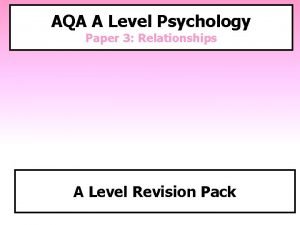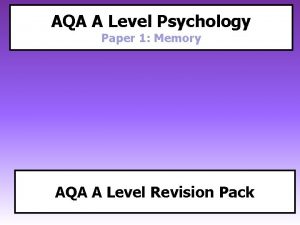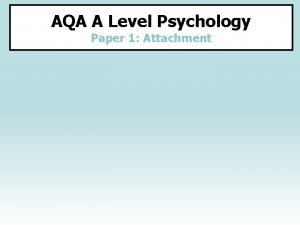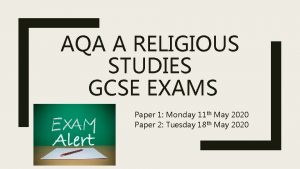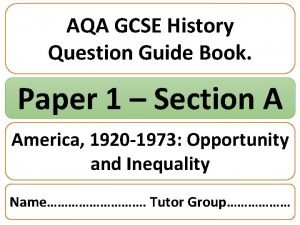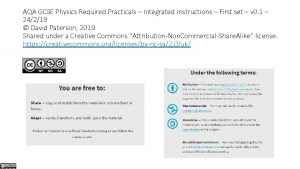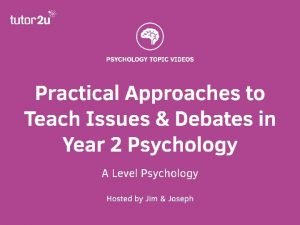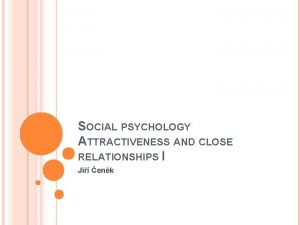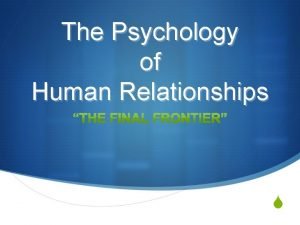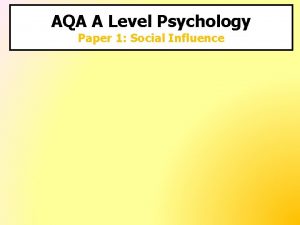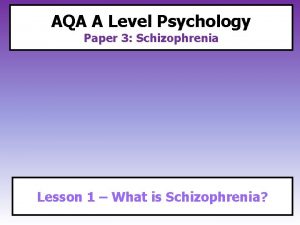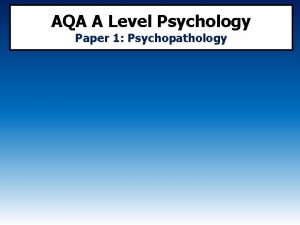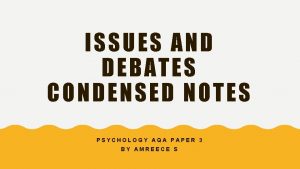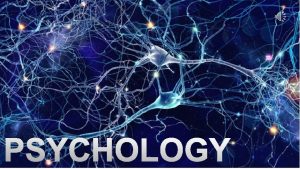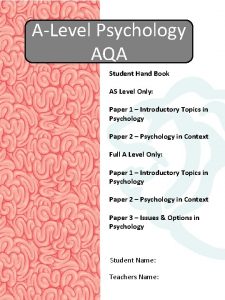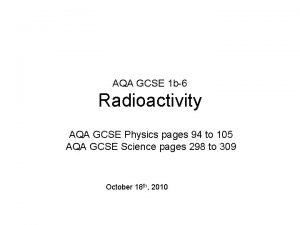AQA A Level Psychology Paper 3 Relationships A

































- Slides: 33

AQA A Level Psychology Paper 3: Relationships A Level Revision Pack

Specification Content; What the AQA say you should know… • Evolutionary explanations for partner preferences. • Including the relationship between sexual selection and human reproductive behaviour.

Evolutionary Explanations for Partner Preferences. Anisogamy - the differences between male and female sex cells (gametes)! Small Highly mobile Produced in high numbers Few in number Produced continuously throughout life. Large Static Produced at Intervals Easy to produce Huge investment of energy

The relationship between sexual selection and human reproductive behaviour. Inter-Sexual Selection (quality not quantity): Preferred strategy of the female. Ovum are rarer than sperm and require greater energy to produce. Females make a greater investment of time, effort and resources both during pregnancy and after birth. Risks of choosing the wrong sexual partner much grater for women – pays to be choosy. Women select their sexual partners looking for 2 things: 1. Genetically fit partner – pass on good genes to offspring – (e. g. facial symmetry) 2. Provider – ease the cost and burden of pregnancy and child rearing. Intra-Sexual Selection (quantity not quality) Preferred strategy of the male. Mate with as many fertile females as possible. Sperm are easy to produce in large numbers with very minimum effort. There is a lack of post coital responsibility after birth. Men select their sexual partners looking for youth and fertility (e. g. a certain body shape or waist to hip ratio).

Evolutionary Explanations for Partner Preferences. Research Evidence: Buss (1989) tested participants form 37 cultures, findings that males prefer young, physically attractive females, where as women prefer resource-rich, ambitious, industrious males. Parlowski & Dubar (1999) examined the idea that older women will not disclose their true age in personal adverts (correlates negatively with fertility). Found it to be true for women aged 3550. Davis (1990) conducted a content analysis of ‘lonely heart ads’ finding that men look for health and attractiveness, and offered wealth and resources. Females looked for status and resources while offering beauty and youth. Toma (2008) found that men were more likely to lie about their education and income than females. Penton Voak (2001) found that females were more physically attracted to males with grater facial symmetry. Dunbar (1995) analyzed 900 lonely heart adverts from 4 US newspapers and found 42% of males sought youthfulness compared to 25% of females. Cartwright (2000) found that women with symmetrical breasts were fertile than women with asymmetric breasts. Langliois & Roggman (1990) used computer imaging to produce faces of varying symmetrical quality and found a preference for greater facial symmetry in both men and women.

Specification Content; What the AQA say you should know… • Factors affecting attraction in romantic relationships including: 1. Self Disclosure 2. Physical Attraction (including The Matching Hypothesis) 3. Filter Theory (including social demography, similarity in attitudes and complementarity)

Factors Affecting Attraction; 1. Self Disclosure (AO 1) • • • Self disclosure is the revealing of personal information about one self to another person – it is crucial for the development of a romantic relationship. We reveal more to those we like – and vice versa. Self disclosure will only happen once sufficient trust has been built up between 2 people. Atman & Taylor (1973) relationships develop between gradual increases in breadth and depth of personal information. Self disclosure is rewarding to the other person, signals liking and the desire to be intimate. We are more attracted to those we find rewarding. • Ajzen (1977) self-disclosure is more a product of information processing and can help us to look positively towards that person. • Disclosure will not always lead to attraction – the following factors are important: 1. 2. 3. 4. Appropriateness of the disclosure – sometimes disclosure can be seen as inappropriate or over the top (first date scenario). Motivations for the disclosure – the reasons we believe someone is disclosing the information is also important (if we believe they disclose information to lots of people we might not be attracted to them). Gender Differences – disclosure by males is sometimes seen as more inappropriate than disclosures by females, or can be seen favourable by certain women. Males may be put off by disclosures by females. Content of the disclosure – the content of the disclosure and the stage of the relationship will be important. For instance, a highly intimate disclosure in the early stages may be off putting.

Factors Affecting Attraction; 1. Self Disclosure (AO 3) Delega & Grzelak (1979) found that those who violated social norms by revealing over personal information were not viewed favourably. Klenike (197) found that individuals who were seen as selective about who they revealed personal information to were viewed as more attractive. Wortman (1976) found that when individuals believed that they had been specially selected for the disclosure, they felt trusted and liked the person more. Derlega and Chaikin (1976) found that men who disclosed personal information were disliked. Dinda & Allen (1992) performed a meta analysis looking at gender and self disclosure finding that women generally preferred men who disclosed intimate information. Brewer & Mittleman (1980) found that the positive impact of disclosure breaks down at extreme levels of intimacy – especially so if in early stages of a relationship. Collins & Miller (1994) found that those who give more intimate self disclosure are seen as more attractive in their meta analysis. They also find that people disclose more to those they are attracted to. Kito (2010) looked at cultural differences between Japanese and American students finding that self disclosure was more important in romantic relationships rather than friendships. Atman & Taylor (1973) disclosing personal information in the early stages of a relationship (1 st date) did not enhance attraction.

Factors Affecting Attraction; 2. Physical Attractiveness (AO 1) • • Physical attractiveness is an immediate and accessible way for potential partners to rate each other. Individuals are not very good at rating their own level of physical attractiveness but generally 2 people can agree on the level of attractiveness of another person. Men are better able to do this than women – this maybe because physical attractiveness in a partner is more important to men than women. Those seen as physically attractive give an impression of being trustworthy, optimistic and sociable. Known as ‘The Halo Effect’ general impression of someone is incorrectly formed based on one characteristic. Evolution sees common attractive features as indicators of genetic fitness/resources (women) or fertility (men). Facial symmetry and muscularity signal genetic fitness in men to women. Large breasts and a small waist to hip ratio signal fertility in women to men. The Matching Hypothesis (Walster et al 1966): • Individuals seek partners who are most like themselves in terms of physical attractiveness. • The individual will assess their own level of attractiveness before focussing attention on people they view as similar to them. • This means there is less chance of rejection. • Individuals will also feel more secure – due to fears that are more attractive partner might be tempted to end the relationship of a more attractive partner became available.

Factors Affecting Attraction; 2. Physical Attractiveness (AO 3) Gunnell & Ceci (2010) found that physically less attractive people 22% more likely to be convicted in court and get prison sentences on average 24 months longer than physically attractive people. Walster & Walster (1969) told student p’s that they had been assigned an ideal partner for a dance (actually random) Those who had been paired with someone similar to them (attractiveness) expressed more liking for their partner. Murstein (1972) asked participants to rate photographs of real couples and non-real couples (put together for the study) in terms of attractiveness. The real couples were rated more similarly than the non real couples. Taylor et al (2011) used photos from online dating profiles finding that people requested communication from people they viewed as MOST attractive (not equal). However, replied were most likely when the individual was seen as similar to them. Walster et al (1966) found that participants liked people who were more physically attractive and that physical attractiveness was the most important factor in wanting to see someone again. – 6 months later, people were with someone similar. Evolutionary theory states that men value attractiveness more than women which means men compensate for a lack of attractiveness in other ways (e. g. good provider). Complex matching is where partners are attracted to someone when they lack physical attractiveness but make up for it in other ways. Third party matching is when a third party (parents/dating site/friend) finds an ideal match – however research has found that when third parties do this they often use physical attractiveness as an indicator. Brigham (1971) found that physically attractive people are seen as having more positive characteristics such as being sociable, interesting, exciting and sexually warm.

Factors Affecting Attraction; 3. Filter Theory (AO 1) • • Choice of partners is affected by factors limiting those available to select from. Series of filters that slim down the field. 1. Social Demographics: • Those people we are realistically able to meet with and who we have things in common with. • For instance – those who live near and work with us, or those of similar ethnicity, religion, educational background. 2. Attitudinal Similarity: • Those people who share the same beliefs and attitudes and values as us. 3. • • • Complementarity: The degree to which another person meets our needs or compliments us in some way. For instance – meets our emotional needs or compliments our personality. Such relationships are deeper and much less superficial.

Factors Affecting Attraction; 3. Filter Theory (AO 3) Festinger (1950) found that people who lives closest to the stairways in an apartment block had the most friendships with other residents – because they came into contact with the most people. Clark (1952) found that 50% of citizens in Columbus were married to partners who initially lived within walking distances of their house. Taylor et al (2010) found that 85% of Americans who got married in 2008, married someone of their own ethnic group. Byrne (1961) found that strangers who had similar attitudes to participants were more liked than strangers with differing attitudes. Tan & Singh 91995)asked 21 year old participants to complete a questionnaire and then exposed them to fake completed questionnaires of a ‘stranger’. They found that they rated strangers with similar attitudes as more attractive. Sadalla et al (1987) found that women were attracted to men who were reliable, socially dominant, self confident and extrovert – allowing them to achieve a high position in society and thus be a good provider. Dijkstra & Barelds (2008) finding that both men and women were attracted to partners who had complementary personality characteristics to themselves. The number of inter-racial marriages has risen considerably since the (1960’s) when it was less that 3%. Much of the research investigating filter theory focuses on liking and relationships in general, rather than romantic relationships and physical attraction.

Specification Content; What the AQA say you should know… Theories of romantic relationships: 1. Social Exchange Theory 2. Equity Theory 3. Rusbult’s Investment Model of Commitment, (satisfaction, comparison with alternatives and investment) 4. Duck’s Phase Model of Relationship Breakdown: intra-psychic, dyadic, social and grave dressing phases.

Theories of Romantic Relationships: 1. Social Exchange Theory (AO 1) • • A theory of relationship maintenance. In any relationship both partners are continually giving and receiving in terms of value i. e. a series of social exchanges. People are fundamentally selfish and are concerned with ‘what they can get’ out of a relationship. Relationships are maintained if both partners feel they are getting more out than what they put in – i. e. a profit situation Rewards - Costs = Profit or Debt (the greater the rewards, the lower the costs, the greater the profit and thus the greater the desire to maintain the relationship). Interactions or exchanges are expensive – they take time, energy, commitment and emotion so we must feel like we are getting something back to continue on. Rewards – friendships, ex, stimulation, affection etc. Costs – freedom given up, time wasted etc. • • • A person assesses their rewards by making 2 comparisons: Comparison Level – rewards are compared against costs to judge profit. Comparison Level for Alternatives – rewards and costs for current relationship are compared against perceived rewards/costs for an alternative relationship. • 1. 2. 3. 4. Thibaut & Kelly (1959) 4 stage model: Sampling – rewards and costs are assessed in a number of relationships. Bargaining – a relationship is costed out, sources of profit and loss are identified. Commitment – relationship is established and maintained by a predictable exchange of rewards. Institutionalisation – exchanges are established and the couple settle down.

Theories of Romantic Relationships: 1. Social Exchange Theory (AO 3) Hatfield (1979) studied participants who felt under or over benefitted in their relationships, finding that the under benefitted felt angry and deprived, whereas the over benefitted felt guilty and uncomfortable. Mills & Clark (1980) distinguished between communal couples who give for one another out of caring and love, and exchange couple who only give to receive. Rusbult (1983) asked participants to complete questionnaires over 7 months asking them about rewards and costs and found that the balance of exchanges was ignored in the early ‘honeymoon’ stage of a relationship. Rusbult (1983) found that in more established relationships, relationship costs led to a significant degree of personal satisfaction. Rusbult & Martz (1995) who looked at the reasons why women stay in abusive relationships. They found that investments are high (children, financial security) and alternatives are low (e. g. nowhere else to live, no money) then they woman may choose to stay in the relationship. Sedikides (2005) believes that people are not fundamentally selfish and are more than capable of doing things for others without expecting anything in return. Murstein (1977) devised the exchange orientation tool which identified people who are suspicious and insecure are concerned with profit in relationships. Cant explain why many people seem to ‘fall out of love’ with their partner and end the relationship when there is no suitable alternative. It also fails to specify just how great the disparity between the current relationship and the comparison level needs to be before the relationship is no longer maintained. Argyle (1988) claims the research that has investigated social exchange theory is contrived and artificial with very little relevance to real life.

Theories of Romantic Relationships: 2. Equity Theory (AO 1) • • • Equity is different to equality. Equality means the same where as equity means fairness. Individuals are motivated to achieve fairness in relationships and feel dissatisfied when they perceive unfairness or inequity. Definitions of inequity can differ between individuals. Relationships where individuals put in more, or receive more than they put in are inequitable – this leads to dissatisfaction and possible dissolution. This model – emphasises the opportunity to save a relationship, at the point of identifying that there is inequity. The relationship can be maintained by a return to equity. Relationships can alternate between periods of balance/equity and imbalance/inequity. • Walster et al (1978) saw equity based on 4 principles: 1. 2. 3. 4. Profit – Rewards are maximised and costs are minimised. Distribution – trade-offs and compensations are negotiated to achieve fairness in a relationship. N Dissatisfaction – the greater the degree of perceived unfairness, the greater the sense of dissatisfaction. Realignment – if restoring equity is possible, the relationship may be maintained (if attempts are made to realign equity). • • •

Theories of Romantic Relationships: 2. Equity Theory (AO 3) Murstein & Mac. Donald (1983) found that married couples are not consciously concerned with ‘getting a fair deal’ in their relationship. Canary & Stafford (992) devised the Relationship Maintenance Strategies Measure (RMSM) to measure the degree of equity in a relationship. They found a link between the degree of perceived equity and number of maintenance strategies. Dainton (2003) studied 219 people in romantic relationships findings that those in relationships where there was a perception of inequity were had low relationship satisfaction but were motivated to try and restore the balance. Yum et al (2009) looked at different type of romantic relationships in 6 different cultures. They found that those in equitable relationships engaged in the most maintenance strategies, followed by those in over benefitted and finally those in under benefitted. They found that culture had little effect. Duck (1988) challenges the selfish nature of exchange theory saying that people are concerned with equity for both themselves and their partners. Sprehcer (1986) believes that close relationships are too complex for this precise assessment of costs and rewards. Mills & Clark (1982) believe that it is not possible to assess equity in loving relationships as much of the investment is emotional which in unquantifiable. Hochschild & Machung (1989) found that equity is more important to women than men as they do most of the work to keep relationships equitable. Argyle (1977) found that people in close relationships do not think in terms of rewards and costs unless they feel dissatisfied.

Theories of Romantic Relationships: 3. Rusbult’s Investment Model of Commitment Theory (AO 1) • • Rusbult’s theory identified the factors determine how committed a relationship is. It identifies the following 3 factors as being positively linked with commitment: 1. • Satisfaction Level Satisfaction is determined by the degree to which the other person meets the individuals needs (e. g. sexual, financial or emotional needs). 2. • • • Comparison with Alternatives: Perceived desirability of the best alternative to the current relationship. This is based on the extent to which an individuals needs could be met within an alternative relationship. If such needs could be better met elsewhere then commitment to the current relationship will be low, if such needs are best met within the current relationship then it will be maintained. 3. • Investment Size: The amount and importance of the resources associated with the relationship and if such resources would decline or to be lost if the relationship were to end. Investments can include direct investment, finances, emotions or indirect such as shared friends, houses children. • There are 2 variables linked to commitment: • Equity – the degree of fairness within a relationship. Unfairness leads to dissatisfaction and the ending of a relationship. • Social Support – the degree of care and assistance available from others such as family and friends – if they approve of a relationship it can have a positive influence and vice versa.

Theories of Romantic Relationships: 3. Rusbult’s Investment Model of Commitment Theory (AO 3) Rusbult et al (1998) gave the IMS (investment model scale) to student participants in relationships – findings that commitment was positively correlated with satisfaction and size of investment, but negatively correlated with quality of alternatives. Rusbult et al (1998) gave the IMS to participants in homosexual relationships finding support for all hypotheses predicted by the model. Duffy & Rusbult (1986) found support for the model when using the IMS with those in marital relationships. Van Lang (1997) used the IMS to measure the quality of relationships with couples from Taiwan. They found support for all factors of the model. . Lin & Rusbult (1995) found support for the model when assessing the quality of relationships with Dutch couples. This model can explain why people stay in abusive relationships, when investments are high (e. g. children) and quality of alternatives are low. This model helps us to understand infidelity – that this behavior will occur when there is low satisfaction with a current relationship and high satisfaction with an alternative relationship. Much of the research investigating this model is heavily reliant on self report measures such as the IMS. Lin & Rusbult (1995) found that although findings were inconsistent, females generally reported higher levels of satisfaction, poorer quality of alternatives, and greater investments than males.

Theories of Romantic Relationships: 4. Duck’s Phase Model of Relationship Breakdown (AO 1) • 1. 2. 3. Duck (2001) proposes 3 reasons why relationships breakdown: Pre Existing Doom – incompatibly and failure are fairly guaranteed from the start. Mechanical Failure – 2 compatible people grow apart and cant be together any longer (most common) Sudden Death – the discovery of infidelity or traumatic event leads to the sudden ending of a relationship. • 1. 2. 3. 4. 5. There are several other factors that contribute to a relationship breakdown: Predisposing personal factors – bad habits, or emotional behaviours. Precipitating factors – exterior influences such as love rivals or incompatible working hours. Lack of skills – sexually inexperienced or poor communication skills Lack of motivation – inequity and a lack of desire to change the situation. Lack of maintenance – spending too much time apart. • 1. 2. 3. 4. Duck said there are 4 phases of relationship breakdown: Intrapsychic Phase – one partner privately perceives dissatisfaction with the relationship. Dyadic Phase – the dissatisfaction is discussed which moves the breakdown to the next stage. Social Phase – the breakdown is made public. There is a negotiation about children/finances etc. Grave Dressing Phase – a post relationship view of the break up is established protecting self esteem and allowing the person to build a new relationship.

Theories of Romantic Relationships: 4. Duck’s Phase Model of Relationship Breakdown (AO 3) Argyle (1988) found that women identified lack of emotional support as a reason for breakdown while men cited absence of fun. Hatfield (1984) found that when an individual experience initial dissatisfaction with a relationship they resent their partner and feel under benefitted. Akert (1992) found that the person who instigate the break up suffers fewer negative consequences than the noninstigator. Tashiro & Frazier (2003) surveyed 92 students about their experiences of relationship breakdown. Participants reported feelings of growth such as feeling stronger emotionally and more independent. The theory does not take into account why dissolution occurred in the first place – i. e. what factor was the starting point? Duck’s four phases are not universal – they do not apply to every case iof relationship breakdown – nor do they always occur in the order described. The model may not apply to homosexual relationships which may not involve some of the decisions over children that heterosexual couples have to consider. Rollie & Duck updated their model in 2006, to add a fifth phase they called ‘resurrection’ which is a period of reconfiguration and preparation for new relationships. Kassin (1996) found that womentare more likely to stress unhappiness and incompatibility as a reason for breakdown, while men blame lack of sex.

Specification Content; What the AQA say you should know… Virtual Relationships in Social Media: 1. Self disclosure in virtual relationships 2. Absence of gating on the nature of virtual relationships.

What is a Virtual Relationship? As internet use has increased, psychologists have become more and more interested in online or virtual relationships and computer mediated communication (CMC). This term encompasses a wide variety of electronic communication by which relationships can be formed.

Virtual Relationships in Social Media: The role of Self Disclosure in Virtual Relationships (AO 1) There are 2 contrasting theories which explain the role of self disclosure in virtual relationships. 1. Reduced Cues Theory (Sproull & Keisser 9186) • CMC relationships are less effective because they lack many of the cues we depend on in face to face interactions. • These include non verbal cues such as our physical appearance and also cues about our emotional state such as facial expressions and tone of voice. • This leads to deindividuation because it reduces people’s sense of individual identity which in turn encourages disinhibition when relating to others, • This can often lead to blunt and aggressive communication which leads to a reluctance to self disclose and makes it unlikely that a relationship will form. 2. The hyperpersonal Model (Joseph Walther 1996, 2011) • Virtual relationships can be more personal and involve more self disclosure than face to face interactions. • In CMC, self disclosure happens a lot earlier which means the relationship develops quicker, once the relationship is more established self disclosure becomes more intense and more intimate. • A key feature of self disclosure in CMC is that the sender of the message has more time to manipulate their online image than they would in a face to face situation. This is called selective self-presentation. • Online, people have more control over what to disclose and present themselves in a positive and idealised way. • Another feature of CMC which promotes self disclosure and makes relationships hyperpersonal is anonymity. • When you have a sense of anonymity you feel less accountable for your behaviour and may well disclose more about yourself than you would normally.

Virtual Relationships in Social Media: The role of Self Disclosure in Virtual Relationships (AO 3) Non verbal cues are different but not absent in CMC. Walther & Tidwell (1995) point out that people in online relationships use other cues such as timing and style of message. Acrostics (LOL) and emoji's can replace non verbal cues. Whitty and Johnson (2009) summarise evidence to show that people self disclose in ways that are hyper-honest and sometimes hyper-dishonest. The extent and depth of disclosure can often depend on the type of CMC used. For instance people self disclose more on social networking as they already have relationships with these people offline, this is very different to online dating where people are communicating with strangers. Walther 2011 points out that any relationship in the real world is ‘mutlimodal’ (use a range of CMC and Ft. F interactions) what we choose to disclose online will be influenced by our offline communication and vice versa. Yum & Hara (2005) found that American participants reported self disclosure led to more trust in an online relationship whereas participants in Korea reported the opposite. Peter et al (2005) found that introverts were motivated to use CMC to make up for their poor social skills, which led to more self disclosure and more intimate virtual relationships.

Virtual Relationships in Social Media: Absence of Gating in Virtual Relationships (AO 1) • A gate, in this context, is any obstacle to the formation of a relationship. • Ft. F relationships are often ‘gated’ in the sense that there are many obstacles that could interfere with the early development of a relationship (physical unattractiveness, a stammer, shyness etc. ) • Mc. Kenna & Bargh (1999) argue that a major advantage of virtual relationships is the absence of gating. • Absence of gating works by focussing attention on self disclosure rather than superficial features of attraction such as how a person looks. • The idea is that once relationships have progressed onto a deeper and more meaningful stage, revelations about ‘gates’ will not be as damaging as they would have been in the real world. • Absence of gating also means that people are free to create online identities that they could never manage face to face. • A man can become a women, an introvert can become an extrovert and so on.

Virtual Relationships in Social Media: Absence of Gating in Virtual Relationships (AO 3) Mc. Kenna & Bargh (2000) looked at CMC used by lonely and socially anxious people. They found that such people were able to express their ‘true selves’ in such relationships – 70% of relationships developed online lasted more than 2 years. The research investigating effects of gating has not considered how the effects may differ between different types of people. Rosemann & Safir (2006) used questionnaires to ask participants about online relationships and found that the online environment allowed people to experiment with different identities than in the real world. Most of the research in this area is based on self report data. This type of data is especially prone to social desirability bias, for example a person may not want to admit they would not interact with a person with a facial disfigurement in the real world. Mc. Kenna et al (2002) as participants to interact with an opposite sex partner either ftf or via CMC for 20 minutes. This was repeated on 10 occasions. In the final condition they all met face to face. It was found that participants liked each other more when they met online rather than ftf.

Specification Content; What the AQA say you should know… Parasocial Relationships: 1. The Absorption Addiction Model 2. The Attachment Theory Explanation

What is a Parasocial Relationship? Parasocial relationships are one sided, unreciprocated relationships, usually with a celebrity, by which the ‘fan’ expends a lot of emotional energy commitment and time. Levels of Parasocial Relationships: John Maltby (2006) used the celebrity attitude scale (Mc. Cutcheon 2002) in a large scale survey and identified 3 levels of parasocial relationships. 1. Entertainment-Social: Least intense level of celebrity worship, celebrities are viewed as sources of entertainment and fuel for social interaction (i. e. gives people something to talk about) Giles (2002) found that parasocial relationships are a source of gossip in offices. 2. Intense Personal: Intermediate levels of celebrity worship, which reflects a greater sense of personal involvement. For example a fan of Kim Kardashian might have frequent thoughts and feelings about her. 3. Borderline Pathological: Strongest level of celebrity worship, features uncontrollable fantasies and extreme behaviours. These might include spending huge amounts of money or time on the celebrity or perform an illegal act. http: //www. nydailynews. com/entertainment/gossip/celebrity-stalking-victims-gallery-1. 45896

Parasocial Relationships: The Absorption Addiction Model (AO 1) • • Mc. Cuctehon (2002) explains the tendency to form parasocial relationships in terms of deficiencies that people have in their own lives (low self confidence, poor relationships, poor psychological health) A parasocial relationship allows them to ‘escape from reality’. This explanation suggests that a personal crisis or a stressful life event can trigger a progression through the levels of parasocial relationships. For example, a death in the family may trigger a progression from entertainment social to intense personal. There are 2 components to this explanation: 1. Absorption: Seeking fulfilment in a celebrity worship motivates the person to focus their attention as far as possible on the celebrity, they want to become absorbed or pre-occupied in their existence. 2. Addiction: Just like with any addiction, the individual needs to sustain their commitment to the relationship by feeling a stronger and closer involvement to the celebrity. This may lead to more extreme behaviours and/or delusional thinking.

Parasocial Relationships: The Absorption Addiction Model (AO 3) Maltby (2005) investigated the link between celebrity worship and body image in males and females aged 14 -16. They found a link between females with poor body image and an intense personal parasocial relationship with a female celebrity whose body shape they admired. Maltby et al (2003) investigated the link between personality types and level of celebrity worship. They found that entertainment social level was linked to extrovert personalities, whereas neurotic personalities were linked to intense personal level and psychotic linked to borderline pathological. Meloy (1998) reported that stalkers often have a history of failed sexual relationships and are usually not in a sexual relationship at the time of stalking. The model has been criticised for being more of a descriptive model than an explanatory one. For example, it can describe the characteristics of people who develop these parasocial relationships, but doesn’t say why. Maltby (2004) found that those in the entertainment social category were usually psychologically healthy, whereas those in higher categories were prone to poor mental health.

Parasocial Relationships: The Attachment Theory Explanation (AO 1) • Various psychologists have suggested that there is a tendency to form parasocial relationships in adolescence and early adulthood because of problems forming attachments in childhood. • Bowlbys’ attachment theory (continuity and internal working model) suggested that any problems with developing attachment in childhood would lead to problems with relationships in later life. • Two attachment types that were identified by Mary Ainsworth insecure resistant and insecure avoidant have been linked to unhealthy relationships. • Insecure resistant types are the people who are most likely to form parasocial relationships. • This is because they need to have their unfulfilled needs met (those that weren’t met in childhood) but in a way that does not have threat of rejection. • Insecure avoidant on the other hand, prefer to just avoid the pain and rejection of any relationship, whether they be social or parasocial.

Parasocial Relationships: The Attachment Theory Explanation (AO 3) Mc. Cutcheon et al 2006 measured attachment types and celebrity attitudes in 299 participants. The study found that those with insecure attachment were no more likely to develop parasocial relationships than those with secure attachments. Much of the research on attachment types and parasocial relationships use self report methods to collect data. Kienlen et al (1997) found that 63% of stalkers experienced a loss of primary caregivers in childhood due to parental separation. They also found that more than 50% had suffered emotional, physical or sexual abuse by their primary caregivers. Most of the studies investigating the link between attachment type and parasocial relationships are correlational which means that we can establish direction of causality. Cole & Leets (1999) found that adolescents with insecure resistant attachment were more likely to develop parasocial relationships than insecure avoidant.
 A level psychology relationships
A level psychology relationships Memory psychology a level questions
Memory psychology a level questions Aqa a level chemistry paper 1 2020
Aqa a level chemistry paper 1 2020 Schaffer and emerson study
Schaffer and emerson study Aqa english language paper 1
Aqa english language paper 1 Geography paper 1 case studies aqa
Geography paper 1 case studies aqa Edexcel gcse english language paper 2
Edexcel gcse english language paper 2 Aqa english language paper 2 rail disasters mark scheme
Aqa english language paper 2 rail disasters mark scheme Aqa economics paper 3 specimen 2015
Aqa economics paper 3 specimen 2015 What paper is inspector calls on
What paper is inspector calls on English literature paper 1 macbeth and inspector calls
English literature paper 1 macbeth and inspector calls Aqa religious studies gcse past papers
Aqa religious studies gcse past papers Gcse history questions
Gcse history questions Edexcel time and place poetry comparison grid
Edexcel time and place poetry comparison grid Aqa english literature paper 1 2019 a christmas carol
Aqa english literature paper 1 2019 a christmas carol Behavioural approach to explaining phobias
Behavioural approach to explaining phobias Countercurrent exchange in fish
Countercurrent exchange in fish Aqa a level drama
Aqa a level drama Aqa physics required practicals
Aqa physics required practicals Aqa a level data sheet
Aqa a level data sheet Social and political protest writing examples
Social and political protest writing examples Aqa a level art and design
Aqa a level art and design Art and design a level aqa
Art and design a level aqa Art and design a level aqa
Art and design a level aqa Aqa a level biology transition guide answers
Aqa a level biology transition guide answers Aqa a level history tudors example answers
Aqa a level history tudors example answers Tutor2u psychology relationships
Tutor2u psychology relationships Attraction and close relationships in social psychology
Attraction and close relationships in social psychology Psychology of human relationships
Psychology of human relationships English general paper paper 2 comprehension
English general paper paper 2 comprehension Aice gen paper
Aice gen paper Worksheet 2 searching algorithms answers
Worksheet 2 searching algorithms answers Geography paper 1 revision notes
Geography paper 1 revision notes Igcse edexcel english literature past papers
Igcse edexcel english literature past papers
